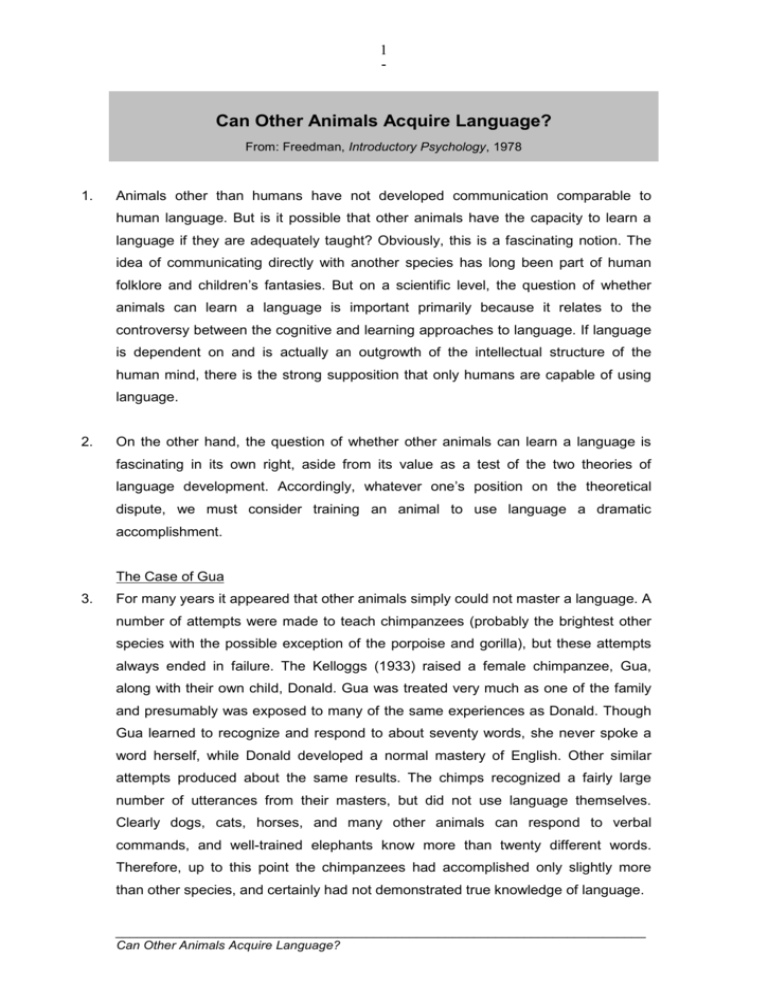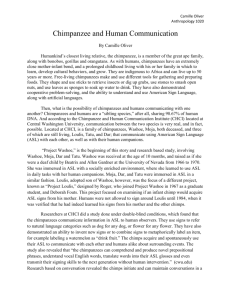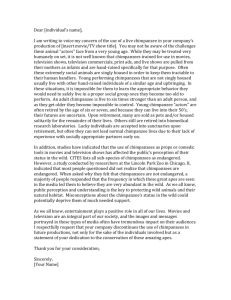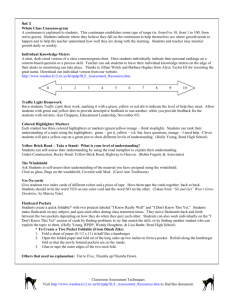Can Other Animals Acquire Language
advertisement

1 - Can Other Animals Acquire Language? From: Freedman, Introductory Psychology, 1978 1. Animals other than humans have not developed communication comparable to human language. But is it possible that other animals have the capacity to learn a language if they are adequately taught? Obviously, this is a fascinating notion. The idea of communicating directly with another species has long been part of human folklore and children’s fantasies. But on a scientific level, the question of whether animals can learn a language is important primarily because it relates to the controversy between the cognitive and learning approaches to language. If language is dependent on and is actually an outgrowth of the intellectual structure of the human mind, there is the strong supposition that only humans are capable of using language. 2. On the other hand, the question of whether other animals can learn a language is fascinating in its own right, aside from its value as a test of the two theories of language development. Accordingly, whatever one’s position on the theoretical dispute, we must consider training an animal to use language a dramatic accomplishment. The Case of Gua 3. For many years it appeared that other animals simply could not master a language. A number of attempts were made to teach chimpanzees (probably the brightest other species with the possible exception of the porpoise and gorilla), but these attempts always ended in failure. The Kelloggs (1933) raised a female chimpanzee, Gua, along with their own child, Donald. Gua was treated very much as one of the family and presumably was exposed to many of the same experiences as Donald. Though Gua learned to recognize and respond to about seventy words, she never spoke a word herself, while Donald developed a normal mastery of English. Other similar attempts produced about the same results. The chimps recognized a fairly large number of utterances from their masters, but did not use language themselves. Clearly dogs, cats, horses, and many other animals can respond to verbal commands, and well-trained elephants know more than twenty different words. Therefore, up to this point the chimpanzees had accomplished only slightly more than other species, and certainly had not demonstrated true knowledge of language. __________________________________________________________________________ Can Other Animals Acquire Language? 2 - The Achievement of Washoe 4. However, the status of animal language was changed dramatically by the accomplishments of Allen and Beatrice Gardner (1971) and their chimpanzee, Washoe. The Gardners decided that trying to teach chimpanzees to talk was hopeless because chimpanzees have great difficulty in the instrumental use of their voices. Instead, they began to teach Washoe American Sign Language, developed for use by deaf-mutes, which clearly was within a chimpanzee’s manipulative capacities. American Sign Language uses complex hand gestures that stand for words, and has its own grammar that is similar to but distinguishable from English. 5. Over several years Washoe learned at least 130 signs that she both understands and uses herself. This has been demonstrated in controlled tests, in which objects or pictures of objects are shown to Washoe and she makes the appropriate sign. Although she is not perfect, she typically gets about fifty right out of one hundred and her errors are usually mistaking one animal for another or one object for one that is quite similar to it. If she were responding by chance, she would only get one or two right out of a hundred since many different items are shown and she knows so many different signs. But it is important to remember that this accomplishment is only quantitatively superior from that of many other animals who learn the meaning of words or signals. The critical difference is that Washoe not only understands but uses these signs. 6. However, the truly significant achievement is that Washoe spontaneously produces combinations of signs that she has never “heard” before. Since the construction of sentences is the essence of language, this is a great step forward in animal language. Washoe knows how to say “open,” “door,” and “window.” Sometimes, entirely on her own, she will make the sign phrase for open-window and open-door. The Gardners have counted 294 different two-sign combinations that Washoe uses, and she probably has made others. Some of these she may have learned directly from the Gardners, but they assure us that many of them were produced by Washoe on her own. Thus, this chimpanzee has mastered 130 meaningful signs and uses them in sentences of two or more signs in order to communicate. Moreover, as she has gotten older and more experienced, Washoe has begun producing longer sign combinations. And other chimps have also learned many signs. 7. Whether this constitutes complete mastery of language is debatable, since Washoe and the others still seem to have little awareness of or use of grammar. On the other __________________________________________________________________________ Can Other Animals Acquire Language? 3 - hand, they can understand and produce a wide variety of messages – much greater than any other nonhuman animal in recorded history. Other Successful Techniques 8. While the Gardners decided to use sign language because it was within the physical capacity of the chimp, Premack (1971) chose something even easier. He tried to teach a chimpanzee to use plastic tokens varying in size, shape, color, and texture to indicate meaning. Although there is some question about the accomplishments of Premack’s chimp Sarah, it is clear that she has learned to recognize a large number of tokens and to combine them in primitive sentences. And other chimps have also reached this level of achievement. Perhaps the most spectacular success has been achieved by a chimp named Lana, who communicates by manipulating symbols on a computerized keyboard. According to her teachers at the Yerkes Primate Laboratory, Lana has learned to ask for the names of new objects. If further research supports these observations, Lana may turn out to be the first nonhuman to demonstrate abstract thought. 9. In short, using various methods of communication, different chimpanzees and an occasional gorilla have managed to communicate at about the level of a somewhat slow four-year-old child. This may not be the limit of the chimps’ abilities – perhaps more intensive or more ingenious training will carry them further – but it is certainly a substantial step beyond what has been done before. If nothing else, it demonstrates the enormous importance of learning in the acquisition of language, and opens up the possibility that someday we will be able to communicate at least on a minimal level with other species. __________________________________________________________________________ Can Other Animals Acquire Language? 4 - __________________________________________________________________________ Can Other Animals Acquire Language?











